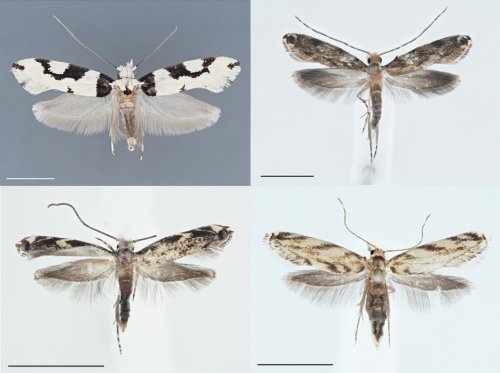Assistant Professor Sadahisa Yagi and his research team have discovered four new species of micro-moths in the Ogasawara Islands
Unveiling the Diversity of Detritivorous Moths on Oceanic Islands and Their Genetic Divergence Across Island groups
Points
- The Ogasawara Islands are home to numerous endemic species and are often referred to as a "natural laboratory of evolution" because they preserve intermediate stages of speciation. Members of the family Tineidae, a group of detritivorous moths capable of adapting to diverse environments, are also thought to have undergone unique speciation in the Ogasawara Islands; however, their diversity has remained largely unknown.
- Field and specimen surveys of the genus Erechthias (Tineidae) in the Ogasawara Islands revealed four new species (see note 1) and two species newly recorded from the islands. Furthermore, DNA analyses of species collected from three or more island groups confirmed clear genetic differentiation between archipelagos in two species.
- The discovery of these endemic species enhances the heritage and scientific value of the Ogasawara Islands and contributes to a deeper understanding of biological evolution on oceanic islands.
Abstract
The Ogasawara Islands, a UNESCO World Heritage Site, are oceanic islands located about 1,000 km south of mainland Japan. They consist of several island groups, including the Mukojima, Chichijima, Hahajima, and Volcano Islands, each harboring numerous endemic species. Because these islands preserve intermediate stages of speciation, they are often referred to as a "natural laboratory of evolution." The family Tineidae, comprising detritivorous moths, inhabits a wide range of environments such as dead wood, fungi, and even bird nests. It is believed that they can also adapt to the unique and isolated environment of the Ogasawara Islands; however, their diversity has remained unexplored.
A research team led by Professor Emeritus Toshiya Hirowatari (Specially Appointed Academic Faculty), Assistant Professor Sadahisa Yagi from the Faculty of Agriculture, Kyushu University, and second-year doctoral student Jinhyeong Park from the Graduate School of Bioresource and Bioenvironmental Sciences, Kyushu University conducted comprehensive field and specimen surveys of the genus Erechthias (Tineidae) in the Ogasawara Islands. As a result, they discovered a total of eight species, including four new species-E. mirabilis (Chichijima-tsumaorega), E. nidumicola (Torinosu-tsumaorega), E. oculus (Medamamon-tsumaorega), and E. flavimacula (Kimon-tsumaorega)-and two species newly recorded from the Ogasawara Islands-E. minuscula (Nanyou-hime-tsumaorega) and E. atririvis (Kurosuji-tsumaorega). Furthermore, DNA analysis based on the COI barcode region (see note 2) of species collected from three or more island groups revealed clear genetic differentiation among island groups in E. nidumicola and E. flavimacula.
The discovery of these endemic species in this study further enhances the heritage value of the Ogasawara Islands as a UNESCO World Natural Heritage site and makes a significant contribution to clarifying the diversity of moths in the region. Moreover, it represents an important step toward deepening our understanding of the processes underlying endemic species formation and biological evolution on oceanic islands.
This study was published in the Pensoft journal ZooKeys, which specializes in animal taxonomy, on Tuesday, August 26, 2025.
Researcher's Comment

(top left: Erechthias mirabilis -- Chichijima-tsumaorega; top right: E. nidumicola -- Torinosu-tsumaorega; bottom left: E. oculus -- Medamamon-tsumaorega; bottom right: E. flavimacula -- Kimon-tsumaorega)
Although the Ogasawara Islands are known to harbor many endemic species, little is known about small insects such as those discovered in this study. This finding represents only the tip of the iceberg, and many more undescribed species remain to be discovered in the future. (Jinhyeong Park)
Glossary
(Note 1) New Species
A species that has been newly described and named scientifically and formally published in accordance with the International Code of Zoological Nomenclature (ICZN). An undescribed species that does not correspond to any known species gains the status of a new species once it is validly published. In contrast, a "newly recorded species" refers to a species that recognized in other regions but is confirmed for the first time in a new locality.
(Note 2) COI Barcode Region
A partial sequence of the cytochrome c oxidase subunit I (COI) gene in mitochondrial DNA. While this region is relatively conserved across many eukaryotic organisms, it exhibits differences between species, making it useful for methods such as DNA barcoding, which identifies species based on sequence information.
Publication Information
Journal: ZooKeys
Title: Taxonomic study of the genus Erechthias (Lepidoptera, Tineidae) from the Ogasawara Islands, with two new records and four new species
Authors: Jinhyeong Park, Sadahisa Yagi, Toshiya Hirowatari
DOI:10.3897/zookeys.1250.154226
- For more details on this research, click here.
For Research-related inquiries












 Contact
Contact
 Access Map
Access Map

